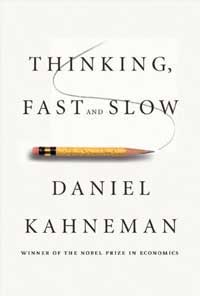 448 pages
448 pages15 CE credits (All chapters)
Course Enrollment
$270.00
Add to Cart
All exams are taken online. The exam for this course will be available in "My Courses" immediately upon enrollment. Note the book is not included.
The book is available for purchase from Amazon.
As an Amazon Associate we receive a rebate from qualifying purchases.
THINKING FAST AND SLOW
Daniel Kahneman, Ph.D.Farrar, Straus and Giroux, 2011
DESCRIPTION
Daniel Kahneman, recipient of the Nobel Prize in Economic Sciences for his seminal work in psychology that challenged the rational model of judgment and decision making, is one of our most important thinkers. His ideas have had a profound and widely regarded impact on many fields-including economics, medicine, and politics-but until now, he has never brought together his many years of research and thinking in one book. In the highly anticipated Thinking, Fast and Slow, Kahneman takes us on a groundbreaking tour of the mind and explains the two systems that drive the way we think. System 1 is fast, intuitive, and emotional; System 2 is slower, more deliberative, and more logical. Kahneman exposes the extraordinary capabilities-and also the faults and biases-of fast thinking, and reveals the pervasive influence of intuitive impressions on our thoughts and behavior. The impact of loss aversion and overconfidence on corporate strategies, the difficulties of predicting what will make us happy in the future, the challenges of properly framing risks at work and at home, the profound effect of cognitive biases on everything from playing the stock market to planning the next vacation-each of these can be understood only by knowing how the two systems work together to shape our judgments and decisions. Engaging the reader in a lively conversation about how we think, Kahneman reveals where we can and cannot trust our intuitions and how we can tap into the benefits of slow thinking. He offers practical and enlightening insights into how choices are made in both our business and our personal lives-and how we can use different techniques to guard against the mental glitches that often get us into trouble. Thinking, Fast and Slow will transform the way you think about thinking.
EDUCATIONAL OBJECTIVESThe reader will be able to:
• Describe Kahneman's approach to understanding thinking: two systems that drive the way we think; System 1 is fast, intuitive, and emotional; System 2 is slower, more deliberative, and more logical
• Describe how fast thinking has extraordinary capabilities and also faults and biases
• Describe the pervasive influence of intuitive impressions on our thoughts and behavior
• Describe the impact of loss aversion and overconfidence on corporate strategies
• Explain the difficulties of predicting what will make us happy in the future
• Examine the challenges of properly framing risks at work and at home
• Explore the profound effect of cognitive biases on everything from playing the stock market to planning the next vacation
• Determine how the two systems work together to shape our judgments and decisions
• Improve the ability to identify errors of judgment and choice in others and in ourselves
• Develop a richer and more precise language to discuss errors
• Limit the damage that bad judgments and choices often cause
• Demonstrate how biases are manifestations of heuristics
• Describe prospect theory
• Describe how emotion affects intuitive judgments
AUTHOR
Daniel Kahneman, Ph.D., is Eugene Higgins Professor of Psychology Emeritus and Professor of Psychology and Public Affairs Emeritus at Princeton's Woodrow Wilson School of Public and International Affairs. He is a recipient of the Nobel Prize in Economics.
ISHK CE at Home
1702-L Meridian Ave., #266
San Jose, CA 95125-5586
This website uses cookies to ensure you get the best experience on our website. Learn more
